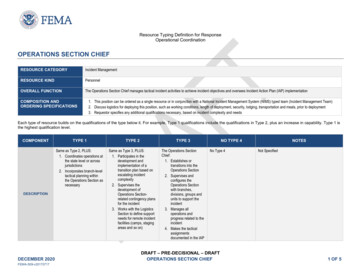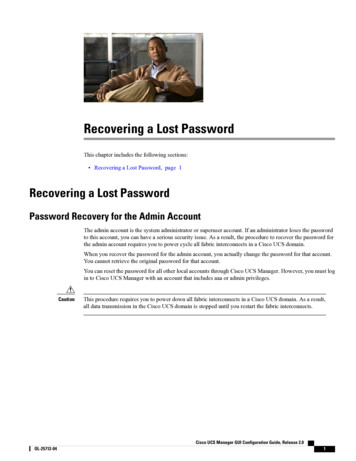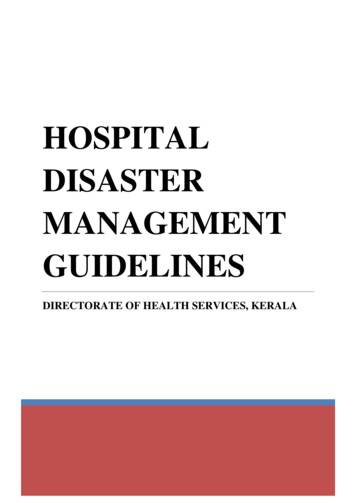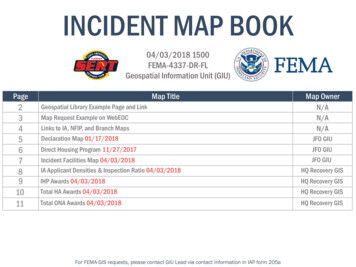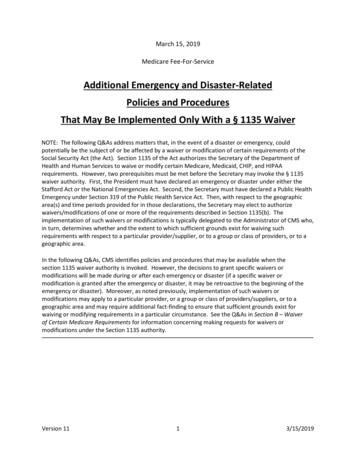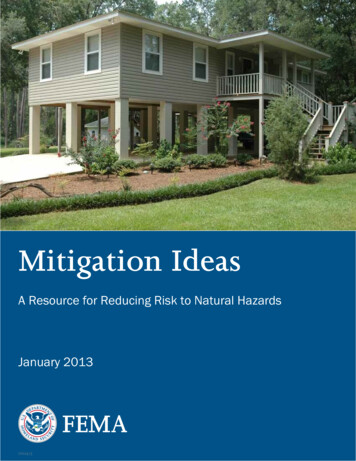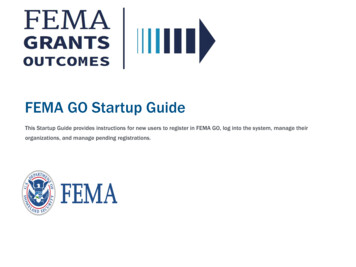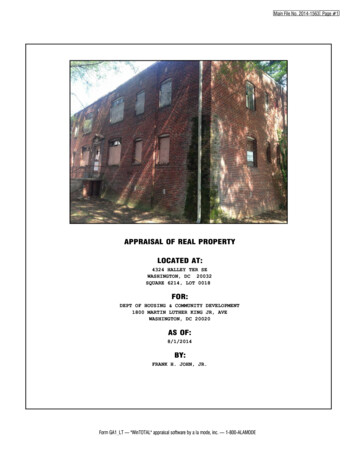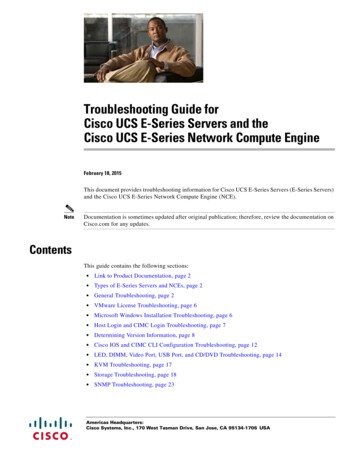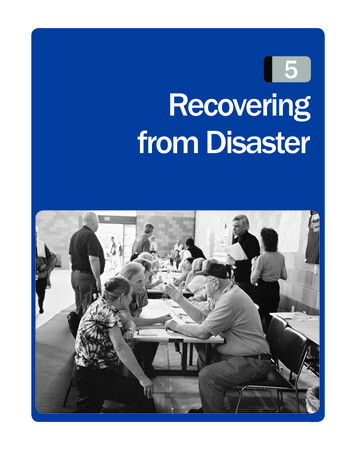
Transcription
5Recoveringfrom Disaster179
5.0Recovering from DisasterAre You Ready?Health and SafetyGuidelinesRecovering from a disaster is usually a gradual process. Safety is a primary issue, asare mental and physical well-being. If assistance is available, knowing how to access it makes the process faster and less stressful. This section offers some generaladvice on steps to take after disaster strikes in order to begin getting your home,your community, and your life back to normal.Your first concern after a disaster is your family’s health and safety. You need toconsider possible safety issues and monitor family health and well-being.Aiding the InjuredCheck for injuries. Do not attempt to move seriously injured persons unless theyare in immediate danger of death or further injury. If you must move an unconscious person, first stabilize the neck and back, then call for help immediately. If the victim is not breathing, carefully position the victim for artificial respiration, clear the airway, and commence mouth-to-mouth resuscitation. Maintain body temperature with blankets. Be sure the victim does not become overheated. Never try to feed liquids to an unconscious person.Health Be aware of exhaustion. Don’t try to do too much at once. Set priorities andpace yourself. Get enough rest. Drink plenty of clean water. Eat well. Wear sturdy work boots and gloves. Wash your hands thoroughly with soap and clean water often when workingin debris.Safety Issues Be aware of new safety issues created by the disaster. Watch for washed outroads, contaminated buildings, contaminated water, gas leaks, broken glass,damaged electrical wiring, and slippery floors. Inform local authorities about health and safety issues, including chemicalspills, downed power lines, washed out roads, smoldering insulation, anddead animals.180
Are You Ready?Recovering from Disaster5.0Returning HomeReturning home can be both physically and mentally challenging. Above all, usecaution.General tips: Keep a battery-powered radio with you so you can listen for emergency updates and news reports. Use a battery-powered flash light to inspect a damaged home.Note: The flashlight should be turned on outside before entering—the battery may produce a spark that could ignite leaking gas, if present. Watch out for animals, especially poisonous snakes. Use a stick to pokethrough debris. Use the phone only to report life-threatening emergencies.Recoveringfrom Disaster Stay off the streets. If you must go out, watch for fallen objects; downed electrical wires; and weakened walls, bridges, roads, and sidewalks.Walk carefully around the outside and check for loose power lines, gas leaks, andstructural damage. If you have any doubts about safety, have your residence inspected by a qualified building inspector or structural engineer before entering.Before You Enter Your YomeDo not enter if: You smell gas. Floodwaters remain around the building. Your home was damaged by fire and the authorities have not declared it safe.When you go inside your home, there are certain things you should and shouldnot do. Enter the home carefully and check for damage. Be aware of loose boardsand slippery floors. The following items are other things to check inside yourhome:Going Inside Your Home181
5.0Recovering from DisasterAre You Ready? Natural gas. If you smell gas or hear a hissing or blowing sound, open awindow and leave immediately. Turn off the main gas valve from the outside,if you can. Call the gas company from a neighbor’s residence. If you shut offthe gas supply at the main valve, you will need a professional to turn it backon. Do not smoke or use oil, gas lanterns, candles, or torches for lightinginside a damaged home until you are sure there is no leaking gas or otherflammable materials present. Sparks, broken or frayed wires. Check the electrical system unless you arewet, standing in water, or unsure of your safety. If possible, turn off the electricity at the main fuse box or circuit breaker. If the situation is unsafe, leavethe building and call for help. Do not turn on the lights until you are surethey’re safe to use. You may want to have an electrician inspect your wiring. Roof, foundation, and chimney cracks. If it looks like the building may collapse, leave immediately. Appliances. If appliances are wet, turn off the electricity at the main fusebox or circuit breaker. Then, unplug appliances and let them dry out. Haveappliances checked by a professional before using them again. Also, have theelectrical system checked by an electrician before turning the power back on. Water and sewage systems. If pipes are damaged, turn off the main watervalve. Check with local authorities before using any water; the water could becontaminated. Pump out wells and have the water tested by authorities beforedrinking. Do not flush toilets until you know that sewage lines are intact. Food and other supplies. Throw out all food and other supplies that you suspect may have become contaminated or come in to contact with floodwater. Your basement. If your basement has flooded, pump it out gradually (aboutone third of the water per day) to avoid damage. The walls may collapse andthe floor may buckle if the basement is pumped out while the surroundingground is still waterlogged. Open cabinets. Be alert for objects that may fall. Clean up household chemical spills. Disinfect items that may have been contaminated by raw sewage, bacteria, or chemicals. Also clean salvageable items. Call your insurance agent. Take pictures of damages. Keep good records ofrepair and cleaning costs.182
Are You Ready?Recovering from Disaster5.0Disaster and life threatening situations will exacerbate the unpredictable nature ofwild animals. To protect yourself and your family, learn how to deal with wildlife.Being Wary of Wildlife andOther AnimalsGuidelines Do not approach or attempt to help an injured or stranded animal. Call yourlocal animal control office or wildlife resource office. Do not corner wild animals or try to rescue them. Wild animals will likelyfeel threatened and may endanger themselves by dashing off into floodwaters,fire, and so forth. Do not approach wild animals that have taken refuge in your home. Wildanimals such as snakes, opossums, and raccoons often seek refuge fromfloodwaters on upper levels of homes and have been known to remain afterwater recedes. If you encounter animals in this situation, open a window orprovide another escape route and the animal will likely leave on its own. Donot attempt to capture or handle the animal. Should the animal stay, call yourlocal animal control office or wildlife resource office. Do not attempt to move a dead animal. Animal carcasses can present serioushealth risks. Contact your local emergency management office or health department for help and instructions.Recoveringfrom Disaster If bitten by an animal, seek immediate medical attention.Seeking Disaster AssistanceThroughout the recovery period, it is important to monitor local radio or television reports and other media sources for information about where to get emergency housing, food, first aid, clothing, and financial assistance. The following sectionprovides general information about the kinds of assistance that may be available.183
5.0Direct AssistanceRecovering from DisasterAre You Ready?Direct assistance to individuals and families may come from any number of organizations, including: American Red Cross. Salvation Army. Other volunteer organization.These organizations provide food, shelter, supplies and assist in clean-up efforts.The Federal RoleIn the most severe disasters, the federal government is also called in to help individuals and families with temporary housing, counseling (for post-disaster trauma), low-interest loans and grants, and other assistance. The federal governmentalso has programs that help small businesses and farmers.Most federal assistance becomes available when the President of the United Statesdeclares a “Major Disaster” for the affected area at the request of a state governor.FEMA will provide information through the media and community outreach aboutfederal assistance and how to apply.Coping with DisasterThe emotional toll that disaster brings can sometimes be even more devastatingthan the financial strains of damage and loss of home, business, or personal property.Understand Disaster Events Everyone who sees or experiences a disaster is affected by it in some way. It is normal to feel anxious about your own safety and that of your family andclose friends. Profound sadness, grief, and anger are normal reactions to an abnormal event. Acknowledging your feelings helps you recover. Focusing on your strengths and abilities helps you heal. Accepting help from community programs and resources is healthy. Everyone has different needs and different ways of coping. It is common to want to strike back at people who have caused great pain.Children and older adults are of special concern in the aftermath of disasters. Evenindividuals who experience a disaster “second hand” through exposure to extensivemedia coverage can be affected.Contact local faith-based organizations, voluntary agencies, or professional counselors for counseling. Additionally, FEMA and state and local governments of theaffected area may provide crisis counseling assistance.184
Are You Ready?Recovering from Disaster5.0When adults have the following signs, they might need crisis counseling or stressmanagement assistance:Recognize Signs of DisasterRelated Stress Difficulty communicating thoughts. Difficulty sleeping. Difficulty maintaining balance in their lives. Low threshold of frustration. Increased use of drugs/alcohol. Limited attention span. Poor work performance. Headaches/stomach problems. Tunnel vision/muffled hearing. Colds or flu-like symptoms. Disorientation or confusion. Difficulty concentrating. Reluctance to leave home. Depression, sadness. Feelings of hopelessness.Recoveringfrom Disaster Mood-swings and easy bouts of crying. Overwhelming guilt and self-doubt. Fear of crowds, strangers, or being alone.The following are ways to ease disaster-related stress:Easing Disaster-RelatedStress Talk with someone about your feelings—anger, sorrow, and other emotions—even though it may be difficult. Seek help from professional counselors who deal with post-disaster stress. Do not hold yourself responsible for the disastrous event or be frustrated because you feel you cannot help directly in the rescue work. Take steps to promote your own physical and emotional healing by healthyeating, rest, exercise, relaxation, and meditation. Maintain a normal family and daily routine, limiting demanding responsibilities on yourself and your family. Spend time with family and friends. Participate in memorials.185
5.0Recovering from DisasterAre You Ready? Use existing support groups of family, friends, and religious institutions. Ensure you are ready for future events by restocking your disaster supplies kitsand updating your family disaster plan. Doing these positive actions can becomforting.Helping Children Copewith DisasterDisasters can leave children feeling frightened, confused, and insecure. Whether achild has personally experienced trauma, has merely seen the event on television,or has heard it discussed by adults, it is important for parents and teachers to beinformed and ready to help if reactions to stress begin to occur.Children may respond to disaster by demonstrating fears, sadness, or behavioralproblems. Younger children may return to earlier behavior patterns, such as bedwetting, sleep problems, and separation anxiety. Older children may also displayanger, aggression, school problems, or withdrawal. Some children who have onlyindirect contact with the disaster but witness it on television may develop distress.Who is at Risk?For many children, reactions to disasters are brief and represent normal reactions to “abnormal events.” A smaller number of children can be at risk for moreenduring psychological distress as a function of three major risk factors: Direct exposure to the disaster, such as being evacuated, observing injuriesor death of others, or experiencing injury along with fearing one’s life is indanger Loss/grief: This relates to the death or serious injury of family or friends On-going stress from the secondary effects of disaster, such as temporarilyliving elsewhere, loss of friends and social networks, loss of personal property,parental unemployment, and costs incurred during recovery to return thefamily to pre-disaster life and living conditions.What Creates Vulnerabilities in Children?In most cases, depending on the risk factors above, distressing responses aretemporary. In the absence of severe threat to life, injury, loss of loved ones, orsecondary problems such as loss of home, moves, etc., symptoms usually diminish over time. For those that were directly exposed to the disaster, reminders ofthe disaster such as high winds, smoke, cloudy skies, sirens, or other remindersof the disaster may cause upsetting feelings to return. Having a prior history ofsome type of traumatic event or severe stress may contribute to these feelings.186
Are You Ready?Recovering from Disaster5.0Children’s coping with disaster or emergencies is often tied to the way parentscope. They can detect adults’ fears and sadness. Parents and adults can makedisasters less traumatic for children by taking steps to manage their own feelingsand plans for coping. Parents are almost always the best source of support forchildren in disasters. One way to establish a sense of control and to build confidence in children before a disaster is to engage and involve them in preparing afamily disaster plan. After a disaster, children can contribute to a family recoveryplan.ReviewSee Section 1:Basic preparednessA Child’s Reaction to Disaster by AgeBelow are common reactions in children after a disaster or traumatic event.Birth through 2 years. When children are pre-verbal and experience a trauma,they do not have the words to describe the event or their feelings. However, theycan retain memories of particular sights, sounds, or smells. Infants may reactto trauma by being irritable, crying more than usual, or wanting to be held andcuddled. The biggest influence on children of this age is how their parents cope.As children get older, their play may involve acting out elements of the traumaticevent that occurred several years in the past and was seemingly forgotten.Recoveringfrom DisasterPreschool—3 through 6 years. Preschool children often feel helpless and powerless in the face of an overwhelming event. Because of their age and small size,they lack the ability to protect themselves or others. As a result, they feel intensefear and insecurity about being separated from caregivers. Preschoolers cannotgrasp the concept of permanent loss. They can see consequences as being reversible or permanent. In the weeks following a traumatic event, preschoolers’ playactivities may reenact the incident or the disaster over and over again.School age—7 through 10 years. The school-age child has the ability to understand the permanence of loss. Some children become intensely preoccupiedwith the details of a traumatic event and want to talk about it continually. Thispreoccupation can interfere with the child’s concentration at school and academic performance may decline. At school, children may hear inaccurate information from peers. They may display a wide range of reactions—sadness, generalized fear, or specific fears of the disaster happening again, guilt over action orinaction during the disaster, anger that the event was not prevented, or fantasiesof playing rescuer.Pre-adolescence to adolescence—11 through 18 years. As children growolder, they develop a more sophisticated understanding of the disaster event.Their responses are more similar to adults. Teenagers may become involved indangerous, risk-taking behaviors, such as reckless driving, or alcohol or druguse. Others can become fearful of leaving home and avoid previous levels ofactivities. Much of adolescence is focused on moving out into the world. After atrauma, the view of the world can seem more dangerous and unsafe. A teenagermay feel overwhelmed by intense emotions and yet feel unable to discuss themwith others.187
5.0Recovering from DisasterAre You Ready?Meeting the Child’s Emotional NeedsChildren’s reactions are influenced by the behavior, thoughts, and feelings ofadults. Adults should encourage children and adolescents to share their thoughtsand feelings about the incident. Clarify misunderstandings about risk anddanger by listening to children’s concerns and answering questions. Maintain asense of calm by validating children’s concerns and perceptions and with discussion of concrete plans for safety.Listen to what the child is saying. If a young child is asking questions about theevent, answer them simply without the elaboration needed for an older child oradult. Some children are comforted by knowing more or less information thanothers; decide what level of information your particular child needs. If a childhas difficulty expressing feelings, allow the child to draw a picture or tell a storyof what happened.Try to understand what is causing anxieties and fears. Be aware that following adisaster, children are most afraid that: The event will happen again. Someone close to them will be killed or injured. They will be left alone or separated from the family.Reassuring Children After a DisasterSuggestions to help reassure children include the following: Personal contact is reassuring. Hug and touch your children. Calmly provide factual information about the recent disaster and current plansfor insuring their safety along with recovery plans. Encourage your children to talk about their feelings. Spend extra time with your children such as at bedtime. Re-establish your daily routine for work, school, play, meals, and rest. Involve your children by giving them specific chores to help them feel theyare helping to restore family and community life. Praise and recognize responsible behavior. Understand that your children will have a range of reactions to disasters. Encourage your children to help update your a family disaster plan.If you have tried to create a reassuring environment by following the steps above,but your child continues to exhibit stress, if the reactions worsen over time, orif they cause interference with daily behavior at school, at home, or with otherrelationships, it may be appropriate to talk to a professional. You can get professional help from the child’s primary care physician, a mental health providerspecializing in children’s needs, or a member of the clergy.188
Are You Ready?Recovering from Disaster5.0Monitor and Limit Your Family’s Exposure to the MediaNews coverage related to a disaster may elicit fear and confusion and arouseanxiety in children. This is particularly true for large-scale disasters or a terrorist event where significant property damage and loss of life has occurred. Particularly for younger children, repeated images of an event may cause them tobelieve the event is recurring over and over.If parents allow children to watch television or use the Internet where imagesor news about the disaster are shown, parents should be with them to encourage communication and provide explanations. This may also include parent’smonitoring and appropriately limiting their own exposure to anxiety-provokinginformation.Use Support NetworksParents help their children when they take steps to understand and managetheir own feelings and ways of coping. They can do this by building and usingsocial support systems of family, friends, community organizations and agencies,faith-based institutions, or other resources that work for that family. Parents canbuild their own unique social support systems so that in an emergency situationor when a disaster strikes, they can be supported and helped to manage theirreactions. As a result, parents will be more available to their children and betterable to support them. Parents are almost always the best source of support forchildren in difficult times. But to support their children, parents need to attendto their own needs and have a plan for their own support.Recoveringfrom DisasterPreparing for disaster helps everyone in the family accept the fact that disastersdo happen, and provides an opportunity to identify and collect the resourcesneeded to meet basic needs after disaster. Preparation helps; when people feelprepared, they cope better and so do children.Helping OthersThe compassion and generosity of the American people is never more evident thanafter a disaster. People want to help. Here are some general guidelines on helpingothers after a disaster: Volunteer! Check with local organizations or listen to local news reports forinformation about where volunteers are needed. Note: Until volunteers arespecifically requested, stay away from disaster areas. Bring your own food, water, and emergency supplies to a disaster area if youare needed there. This is especially important in cases where a large area hasbeen affected and emergency items are in short supply. Give a check or money order to a recognized disaster relief organization.These groups are organized to process checks, purchase what is needed, andget it to the people who need it most.189
5.0Recovering from DisasterAre You Ready? Do not drop off food, clothing, or any other item to a government agencyor disaster relief organization unless a particular item has been requested.Normally, these organizations do not have the resources to sort through thedonated items. Donate a quantity of a given item or class of items (such as nonperishablefood) rather than a mix of different items. Determine where your donationis going, how it’s going to get there, who is going to unload it, and how it isgoing to be distributed. Without sufficient planning, much needed supplieswill be left unused.For More InformationIf you require more information about any of these topics, the following areresources that may be helpful.FEMA PublicationsHelping Children Cope with Disasters. L-196. Provides information about how to preparechildren for disaster and how to lessen the emotional effects of disaster.When Disaster Strikes. L-217. Provides information about donations and volunteerorganizations.Repairing Your Flooded Home. FEMA 234. This 362-page publication provides a stepby-step guide to repairing your home and how to get help after a flood disaster.Available online at www.fema.gov/hazards/floods/lib234.shtmAfter a Flood: The First Steps. L 198. Tips for staying healthy, cleaning up and repairing,and getting help after a flood. Available online at www.fema.gov/hazards/floods/aftrfld.shtm190
local animal control offi ce or wildlife resource offi ce. Do not attempt to move a dead animal. Animal carcasses can present serious health risks. Contact your local emergency management offi ce or health de-partment for help and instructions. If bitten by an animal, seek immediate medical attention. Seeking Disaster Assistance
